
- Selenium - Home
- Selenium - Overview
- Selenium - Components
- Selenium - Automation Testing
- Selenium - Environment Setup
- Selenium - Remote Control
- Selenium - IDE Introduction
- Selenium - Features
- Selenium - Limitations
- Selenium - Installation
- Selenium - Creating Tests
- Selenium - Creating Script
- Selenium - Control Flow
- Selenium - Store Variables
- Selenium - Alerts & Popups
- Selenium - Selenese Commands
- Selenium - Actions Commands
- Selenium - Accessors Commands
- Selenium - Assertions Commands
- Selenium - Assert/Verify Methods
- Selenium - Locating Strategies
- Selenium - Script Debugging
- Selenium - Verification Points
- Selenium - Pattern Matching
- Selenium - JSON Data File
- Selenium - Browser Execution
- Selenium - User Extensions
- Selenium - Code Export
- Selenium - Emitting Code
- Selenium - JavaScript Functions
- Selenium - Plugins
- Selenium WebDriver Tutorial
- Selenium - Introduction
- Selenium WebDriver vs RC
- Selenium - Installation
- Selenium - First Test Script
- Selenium - Driver Sessions
- Selenium - Browser Options
- Selenium - Chrome Options
- Selenium - Edge Options
- Selenium - Firefox Options
- Selenium - Safari Options
- Selenium - Double Click
- Selenium - Right Click
- HTML Report in Python
- Handling Edit Boxes
- Selenium - Single Elements
- Selenium - Multiple Elements
- Selenium Web Elements
- Selenium - File Upload
- Selenium - Locator Strategies
- Selenium - Relative Locators
- Selenium - Finders
- Selenium - Find All Links
- Selenium - User Interactions
- Selenium - WebElement Commands
- Selenium - Browser Interactions
- Selenium - Browser Commands
- Selenium - Browser Navigation
- Selenium - Alerts & Popups
- Selenium - Handling Forms
- Selenium - Windows and Tabs
- Selenium - Handling Links
- Selenium - Input Boxes
- Selenium - Radio Button
- Selenium - Checkboxes
- Selenium - Dropdown Box
- Selenium - Handling IFrames
- Selenium - Handling Cookies
- Selenium - Date Time Picker
- Selenium - Dynamic Web Tables
- Selenium - Actions Class
- Selenium - Action Class
- Selenium - Keyboard Events
- Selenium - Key Up/Down
- Selenium - Copy and Paste
- Selenium - Handle Special Keys
- Selenium - Mouse Events
- Selenium - Drag and Drop
- Selenium - Pen Events
- Selenium - Scroll Operations
- Selenium - Waiting Strategies
- Selenium - Explicit/Implicit Wait
- Selenium - Support Features
- Selenium - Multi Select
- Selenium - Wait Support
- Selenium - Select Support
- Selenium - Color Support
- Selenium - ThreadGuard
- Selenium - Errors & Logging
- Selenium - Exception Handling
- Selenium - Miscellaneous
- Selenium - Handling Ajax Calls
- Selenium - JSON Data File
- Selenium - CSV Data File
- Selenium - Excel Data File
- Selenium - Cross Browser Testing
- Selenium - Multi Browser Testing
- Selenium - Multi Windows Testing
- Selenium - JavaScript Executor
- Selenium - Headless Execution
- Selenium - Capture Screenshots
- Selenium - Capture Videos
- Selenium - Page Object Model
- Selenium - Page Factory
- Selenium - Record & Playback
- Selenium - Frameworks
- Selenium - Browsing Context
- Selenium - DevTools
- Selenium Grid Tutorial
- Selenium - Overview
- Selenium - Architecture
- Selenium - Components
- Selenium - Configuration
- Selenium - Create Test Script
- Selenium - Test Execution
- Selenium - Endpoints
- Selenium - Customizing a Node
- Selenium Reporting Tools
- Selenium - Reporting Tools
- Selenium - TestNG
- Selenium - JUnit
- Selenium - Allure
- Selenium & Other Technologies
- Selenium - Java Tutorial
- Selenium - Python Tutorial
- Selenium - C# Tutorial
- Selenium - Javascript Tutorial
- Selenium - Kotlin Tutorial
- Selenium - Ruby Tutorial
- Selenium - Maven & Jenkins
- Selenium - LogExpert Logging
- Selenium - Log4j Logging
- Selenium - Robot Framework
- Selenium - Github Tutorial
- Selenium - IntelliJ
- Selenium - XPath
- Selenium Miscellaneous Concepts
- Selenium - IE Driver
- Selenium - Automation Frameworks
- Selenium - Keyword Driven Framework
- Selenium - Data Driven Framework
- Selenium - Hybrid Driven Framework
- Selenium - SSL Certificate Error
- Selenium - Alternatives
Selenium WebDriver - Action Class
Selenium Webdriver can be used to perform keyboard and mouse operations. This includes actions like drag and drop, click, double click, right click, working with control keys, other key operations, and so on. All these actions are carried out with designated user exchange APIs, known as the Actions class in Selenium Webdriver.
Action Class Methods
Some of the methods available in the Actions class are listed below −
- click() − This method is used to perform click at the present location of the mouse.
- build() − This method is used to create a combination of actions having all the actions to be carried on.
- perform() − This method is used to perform actions without invoking the build() first.
- release() − This method is used to release mouse action at the present location of the mouse.
- release(WebElement e) − This method is used to release mouse action at the middle of the webElement e passed as a parameter.
- doubleClick(WebElement e) − This method is used to perform double click at the middle of the webElement e passed as a parameter.
- click(WebElement e) − This method is used to perform click at the middle of the webElement e passed as a parameter.
- doubleClick() − This method is used to perform double click at the present location of the mouse.
- contextClick() − This method is used to perform a right click at the present location of the mouse.
- contextClick(WebElement e) − This method is used to perform a right click at the middle of the webElement e passed as a parameter.
- moveToElement(WebElement e) − This method is used to move the mouse to the middle of the webElement e passed as a parameter.
- moveToElement(WebElement e, int x-offset, int y-offset) − This method is used to move the mouse to an offset from the element in view point. The webelement e, x, and y offset values are passed as parameters.
- clickAndHold() − This method is used to perform click(without releasing) at the present location of the mouse.
- clickAndHold(WebElement e) − This method is used to perform click(without releasing) at the middle of the webElement e passed as a parameter.
- keyDown(CharSequence key) − This method is used to perform a modifier key press, passed as a parameter.
- keyDown(WebElement e, CharSequence key) − This method is used to perform a modifier key press post focusing an element. The webElement e, and key to be pressed are passed as parameters.
- keyUp(CharSequence key) − This method is used to perform a modifier key release, passed as a parameter.
- keyUp(WebElement e, CharSequence key) − This method is used to perform a modifier key release post focusing an element. The webElement e, and key to be released are passed as parameters.
- sendKeys(CharSequence key) − This method is used to send keys to elements in focus. The key to be sent is passed as a parameter.
- sendKeys(WebElement e, CharSequence key) − This method is used to send keys to the webElement passed as parameter.
Please note that, while using the methods of Actions class, we would need to add the import statement −
import org.openqa.selenium.interactions.Actions in our tests.
Example 1 - Click, Right & Double Clicks
Let us take an example of the below page, where we would perform click, right click, and double click by clicking on the Click Me, Right Click Me, and Double Click Me buttons respectively on the web page.
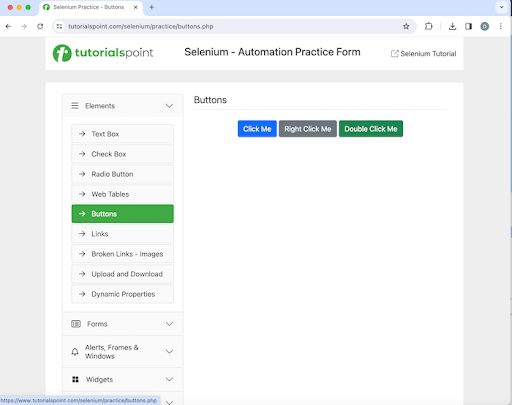
On performing the Click Me, Right Click Me, and Double Click Me buttons respectively, we would get a message You have a dynamic click and You have double clicked messages on the page respectively.
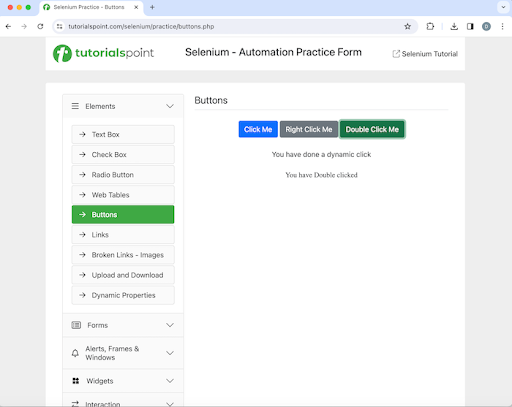
Code Implementation
package org.example;
import org.openqa.selenium.By;
import org.openqa.selenium.WebDriver;
import org.openqa.selenium.WebElement;
import org.openqa.selenium.chrome.ChromeDriver;
import org.openqa.selenium.interactions.Actions;
import java.util.concurrent.TimeUnit;
public class ActionsMouse {
public static void main(String[] args) throws InterruptedException {
// Initiate the Webdriver
WebDriver driver = new ChromeDriver();
// adding implicit wait of 15 secs
driver.manage().timeouts().implicitlyWait(15, TimeUnit.SECONDS);
// Opening the webpage
driver.get("https://www.tutorialspoint.com/selenium/practice/buttons.php");
// identify element with xpath for click
WebElement m = driver.findElement
(By.xpath("/html/body/main/div/div/div[2]/button[1]"));
// object of Actions class to move then click
Actions a = new Actions(driver);
a.moveToElement(m).click().build().perform();
// get text after click
WebElement t = driver.findElement(By.xpath("//*[@id='welcomeDiv']"));
System.out.println("Text after click: " + t.getText());
// identify element with xpath for double click
WebElement n = driver.findElement
(By.xpath("/html/body/main/div/div/div[2]/button[3]"));
// double click
a.moveToElement(n).doubleClick().build().perform();
// get text after double click
WebElement x = driver.findElement(By.xpath("//*[@id='doublec']"));
System.out.println("Text after double click: " + x.getText());
// identify element with xpath for right click
WebElement y = driver.findElement
(By.xpath("/html/body/main/div/div/div[2]/button[2]"));
// right click
a.moveToElement(y).contextClick().build().perform();
// Closing browser
driver.quit();
}
}
Output
Text after click: You have done a dynamic click Text after double click: You have Double clicked Process finished with exit code 0
In the above example, we had performed click, double click, and right click and then received the messages in the console - Text after click: You have done a dynamic click and Text after double click: You have Double clicked.
Finally, the message Process finished with exit code 0 was received, signifying successful execution of the code.
Example 2 - Mouse Hover
Let us take another example, where initially the menu Navbar has a black color.
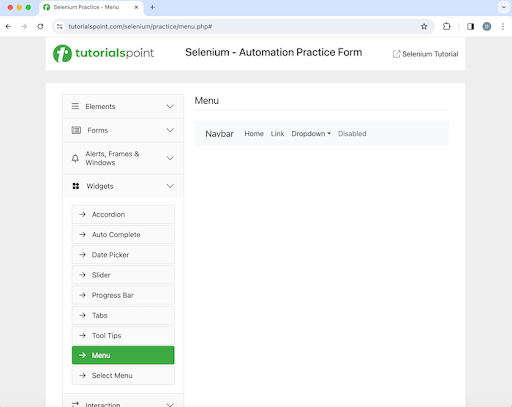
However, on hovering and holding on it, the menu Navbar changes color from black to green as shown in the below image.
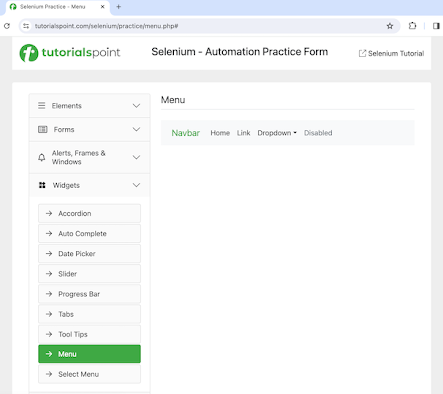
Code Implementation
package org.example;
import org.openqa.selenium.By;
import org.openqa.selenium.WebDriver;
import org.openqa.selenium.WebElement;
import org.openqa.selenium.chrome.ChromeDriver;
import org.openqa.selenium.interactions.Actions;
import java.util.concurrent.TimeUnit;
public class ActionsClickandHold {
public static void main(String[] args) throws InterruptedException {
// Initiate the Webdriver
WebDriver driver = new ChromeDriver();
// adding implicit wait of 15 secs
driver.manage().timeouts().implicitlyWait(15, TimeUnit.SECONDS);
// Opening the webpage
driver.get("https://www.tutorialspoint.com/selenium/practice/menu.php#");
// identify element with xpath for click and hold
WebElement m = driver.findElement
(By.xpath("/html/body/main/div/div/div[2]/nav/div/a"));
// get element color in rgba format
String s = m.getCssValue("color");
System.out.println("rgba code for color element: " + s );
// object of Actions class to click and hold
Actions a = new Actions(driver);
a.clickAndHold(m).build().perform();
// get element color in rgba format
String c = m.getCssValue("color");
System.out.println("rgba code for color for element after click and hold: " + c);
// Closing browser
driver.quit();
}
}
Output
rgba code for color element: rgba(51, 51, 51, 1) rgba code for color for element after click and hold: rgba(64, 169, 68, 1) Process finished with exit code 0
Example 3 - Drag and Drop
Let us take an example of the above page, where we would drag the source box with the text - Drag me to my target to the destination box having the text - Drop here.
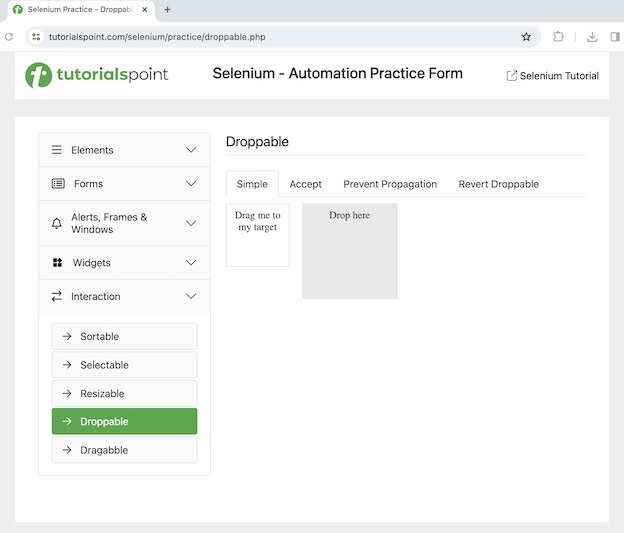
Once the entire action has been completed, we would get the text - Dropped! on the web page as highlighted on the below image.
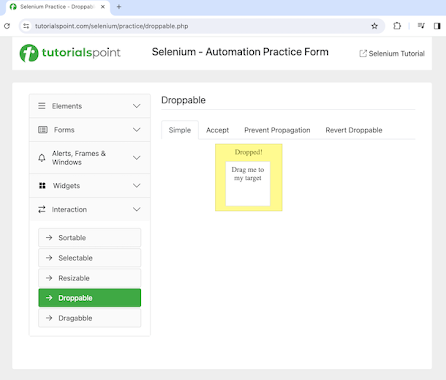
Code Implementation
package org.example;
import org.openqa.selenium.By;
import org.openqa.selenium.WebDriver;
import org.openqa.selenium.WebElement;
import org.openqa.selenium.chrome.ChromeDriver;
import org.openqa.selenium.interactions.Actions;
import java.util.concurrent.TimeUnit;
public class DragAndDrp {
public static void main(String[] args) throws InterruptedException {
// Initiate the Webdriver
WebDriver driver = new ChromeDriver();
// adding implicit wait of 15 secs
driver.manage().timeouts().implicitlyWait(15, TimeUnit.SECONDS);
// URL launch for accessing drag and drop elements
driver.get("https://www.tutorialspoint.com/selenium/practice/droppable.php");
// identify source and target elements for drag and drop
WebElement sourceElement= driver.findElement(By.id("draggable"));
WebElement targetElement= driver.findElement(By.id("droppable"));
// drag and drop operations without build and perform methods
Actions a = new Actions(driver);
a.dragAndDrop(sourceElement, targetElement).build().perform();
// identify text after element is dropped
WebElement text = driver.findElement(By.xpath("//*[@id='droppable']/p"));
System.out.println("Text is : " + text.getText());
// quitting browser after drag and drop operations completed
driver.quit();
}
}
Output
Text is after dragging: Dropped! Process finished with exit code 0
In the above example, we had first performed a drag and drop operation from the source to the destination locator, and also received the message in the console - Text is : Dropped!(which is received after drag and drop operation has been completed in this application).
Finally, the message Process finished with exit code 0 was received, signifying successful execution of the code.
Example 4 - Key Operation
Let us take another example, where we would enter text SELENIUM in an input box in capital letters using the Key Up Key Down methods of Action class. Please note that, while sending the value to the sendKeys() method, we would pass selenium along with pressing SHIFT keys. Hence, we would get the output entered in the input box as SELENIUM.
package org.example;
import org.openqa.selenium.By;
import org.openqa.selenium.Keys;
import org.openqa.selenium.WebDriver;
import org.openqa.selenium.WebElement;
import org.openqa.selenium.chrome.ChromeDriver;
import org.openqa.selenium.interactions.Actions;
import java.util.concurrent.TimeUnit;
public class KeyAction {
public static void main(String[] args) throws InterruptedException {
// Initiate the Webdriver
WebDriver driver = new ChromeDriver();
// adding implicit wait of 15 secs
driver.manage().timeouts().implicitlyWait(15, TimeUnit.SECONDS);
// Opening the webpage where we will identify an element
driver.get("https://www.tutorialspoint.com/selenium/practice/text-box.php");
// Identify the first input box with xpath locator
WebElement e = driver.findElement(By.xpath("//*[@id='fullname']"));
// Actions class
Actions a = new Actions(driver);
// moving to an input box and clicking on it
a.moveToElement(e).click();
// key UP and DOWN action for SHIFT
a.keyDown(Keys.SHIFT);
a.sendKeys("Selenium").keyUp(Keys.SHIFT).build().perform();
// get value entered
System.out.println("Text entered: " + e.getAttribute("value"));
// Closing browser
driver.quit();
}
}
Output
Text entered: SELENIUM Process finished with exit code 0
In the above example, we had entered the text selenium along with pressing SHIFT key in the input box and hence obtained the entered text in upper case with the message in the console − Text entered: SELENIUM.
Finally, the message Process finished with exit code 0 was received, signifying successful execution of the code.
Conclusion
This concludes our comprehensive take on the tutorial on Selenium Webdriver Action Class. Weve started with describing an Action class and walked through various methods of Action class, and examples illustrating how to perform click, right click, double click, mouse hovering, drag and drop, and key operation along with Selenium. This equips you with in-depth knowledge of the Action Class. It is wise to keep practicing what youve learned and exploring others relevant to Selenium to deepen your understanding and expand your horizons.